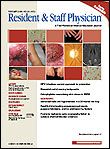Publication
Article
Resident & Staff Physician®
ECG Rounds
Wamiq Y. Banday, MD, Resident, Internal Medicine Residency Program, Sisters of Charity Hospital, University of Buffalo, Buffalo, and Jawaid Shaw, MD, Resident, Department of Internal Medicine, Rochester General Hospital, Rochester, NY
Question
A 51-year-old African-American man presents to the emergency department with a 1-week history of sudden onset of exertion-induced breathlessness associated with light-headedness. He has no fever, cough, chest pain, orthopnea, or paroxysmal nocturnal dyspnea. His history includes type 2 diabetes and hypertension. His vital signs are: blood pressure, 157/100 mm Hg; heart rate, 93 beats/min; respiratory rate, 15 breaths/min; temperature, 98.7° F. The physical examination is remarkable for pallor and bilateral pedal edema, with no evidence of jugular venous distention or tenderness in the lower limbs. Lungs are clear to auscultation. Arterial blood gases on room air are: pH, 7.48 (normal range, 7.35-7.45); PCO2, 29.0 mm Hg (normal, 35-45); PO2, 53.0 mm Hg (normal, 80-100); bicarbonate, normal (at 21.4 mmol/L); troponin, normal (at 0.15 µg/L); B-type natriuretic peptide, 217 pg/mL (normal, <100). A 12-lead electrocardiogram (ECG) is obtained (Figure).
Figure
How would you interpret this ECG?
ECG Rounds Answer
Diagnosis: Acute cor pulmonale caused by pulmonary embolism (S1Q3T3 pattern).
Pulmonary embolism ranges from incidental, clinically unimportant thromboembolism to massive embolism with sudden death. Acute pulmonary embolism causes elevated pulmonary artery and right heart pressures and decreased cardiac output, which will be reflected in the ECG by the S1Q3T3 pattern. However, when the ECG changes persist even after the pulmonary artery pressure and the right heart size have returned to normal, additional mechanisms are involved,1 including the release of catecholamine or histamine at the cellular level.2,3
This patient's ECG shows: sinus tachycardia (with a rate of 100/min), S wave in lead I,Q wave in lead III, and T-wave inversion in lead III (S1Q3T3 pattern); Q waves are also seen in leads II and aVF; T-wave inversion is seen in leads V1 through V4 (anterior leads); complete right bundle-branch block (RBBB); and ST-segment depression in leads V4 through V6. These findings make this ECG very suspicious for pulmonary embolism. A computed tomography scan of the chest with contrast showed large bilateral pulmonary embolisms.
The S1Q3T3 pattern was first described in 1935,4 and transient RBBB was first described in 1939.5 However, the S1Q3T3 pattern varies in about 12% to 50% of cases and is therefore not pathogonomic.3 This pattern will resolve within 14 days of onset of disease. Up to 25% of patients with pulmonary embolism have normal ECG at admission.6 Transient RBBB is seen in 6% to 67% of patients with pulmonary embolism.1 ST elevation or depression is seen in up to 50% of this type of patients.7 T-wave inversion, diffuse or in the inferior leads, is a frequent finding in pulmonary embolism and is a sign of massive disease; however, good prognostic value has been reported when the T-wave inversion is reversed before the sixth day.6
Our patient's ECG had all these findings, making this ECG a prototype for pulmonary embolism as described in the literature. However, the sensitivity and specificity of ECG changes in pulmonary embolism are 26.7% and 57.1%, respectively, and are therefore not sufficient for the diagnosis.1
Other ECG abnormalities described in the literature include rhythm disturbances, such as sinus tachycardia (8%-69%), first-degree AV block (1%-12%), premature atrial or premature ventricular beats (4%-23%), atrial fibrillation (18%) and atrial flutter (35%), and P-pulmonale (2%-31%)1; as well as PR depression and low-voltage complexes7
References
- Chan TC, Vilke GM, Pollack M, et al. Electrocardiographic manifestations: pulmonary embolism. J Emerg Med. 2001;21:263-270.
- Yoshinaga T, Ikeda S, Nishimura E, et al. Serial changes in negative T waves on electrocardiogram in acute pulmonary thromboembolism. Int J Cardiol. 1999;72:65-72.
- Ferrari E, Imbert A, Chevalier T, et al. The ECG in pulmonary 80 case reports. Chest. 1997;111:537-543.
- Palla A, Petruzzelli S, Donnamaria V, et al. The role of suspicion in the diagnosis of pulmonary embolism. Chest. 1995;107(1 suppl):21S-24S.
- Durant TM, Ginsberg IW, Roesler H. Transient bundle branch block and other electrocardiographic changes in pulmonary embolism. Am Heart J. 1939;17:423-430.
- Sreeram N, Cheriex EC, Smeets JL, et al. Value of the 12-lead electrocardiogram at hospital admission in the diagnosis of pulmonary embolism. Am J Cardiol. 1994;73:298-303.
- Petruzzelli S, Palla A, Pieraccini F, et al. Routine electrocardiography in screening for pulmonary embolism. Respiration. 1986;50:233-243.
